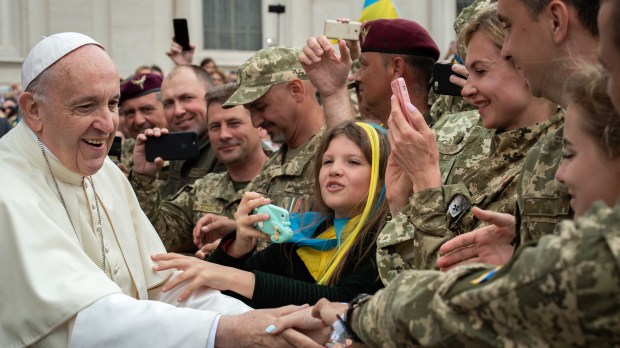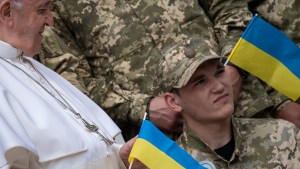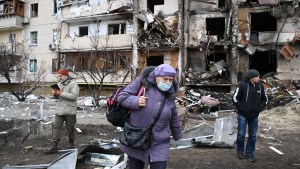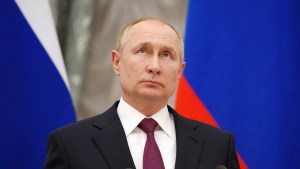For months, Pope Francis has been making calls for peace in the conflict between Russian forces and Ukrainians.
His break with protocol on February 25, 2022, to personally visit the Russian Embassy to the Holy See, was a highlight. But that surprise visit was just one more step in a series of actions to appeal for and bring about peace.
Here’s a look back at a year of appeals and actions by the Argentine Pontiff and his closest collaborators on the Ukrainian issue.
On March 25, 2021, Pope Francis received Denys Smyhal, Prime Minister of Ukraine, at the Vatican. The “dramatic situation” in the east of the country was discussed during a meeting with Cardinal Pietro Parolin, the pope’s Secretary of State. Subsequently Major Archbishop Shevchuk emphasized: “I’m committed to dialogue because with dialogue we can heal the wounds and peace will prevail over war.”
On April 18, 2021, the pope said he was following with concern the evolution of the conflict in Ukraine, “where in recent months there has been an increase in ceasefire violations.” After reciting the Regina Caeli prayer from the window of the Apostolic Palace, he asked that gestures of peace be made.
On June 29, 2021, Ukrainian President Volodymyr Zelensky called Pope Francis on the occasion of the feast of Saints Peter and Paul. The two heads of state discussed the conflict that has been ongoing in the region since 2013. They had met at the Vatican in February 2020.
On December 12, 2021, from the window of the Vatican’s Apostolic Palace, the pope made an appeal for peace in Ukraine after praying the Sunday Angelus. “Weapons are not the way,” he warned, assuring that he was praying for “dear Ukraine, for all its Churches and religious communities, and for all its people.”
On January 10, 2022, in his address to the diplomatic corps accredited to the Holy See, Pope Francis spoke of the Ukrainian situation in one sentence: “Reciprocal trust and readiness to engage in calm discussion should also inspire all parties at stake, so that acceptable and lasting solutions can be found in Ukraine and in the southern Caucasus, and the outbreak of new crises can be avoided in the Balkans, primarily in Bosnia and Herzegovina.”
On January 23, 2022, the pope launched a solemn appeal for peace in Ukraine and in Europe after the Angelus. Without mentioning the name of Russia, he declared Wednesday 26 January a “Day of Prayer for Peace.”
On January 26, the pope said, “I ask you to pray the Our Father for peace in Ukraine, now and throughout this Day.” He urged that “all hurts, fears and divisions” be overcome.
On February 9, during the Wednesday general audience, Pope Francis once again called for prayer for peace in Ukraine. Asking “that tensions and threats of war be overcome through serious dialogue,” he particularly encouraged the “Normandy Format” talks – a fourfold diplomatic configuration established in 2014 that brings together Ukraine, Russia, France and Germany.
On February 13, Pope Francis said that “the news coming out of Ukraine is very worrying.” On the sidelines of the Angelus, he said he entrusts “every effort for peace to the intercession of the Virgin Mary and to the conscience of the political leaders,” inviting the crowd in St. Peter’s Square to pray in silence with him.
On February 20, the pope declared that it is “sad that people who are proud to be Christians see others as enemies and think of waging war against each other” during his catechesis at the Angelus. On this occasion, the Pontiff made no explicit reference to tensions between Ukraine and Russia.
On February 23, Pope Francis expressed his “great sorrow” for the “deterioration of the situation in Ukraine” during the general audience. He decreed a Day of Fasting for Peace on March 2, Ash Wednesday, to respond to the “diabolical absurdity of violence.”
The war begins
From here, the chronology goes in reverse, starting with the most current steps at the top.
On March 23, Pope Francis declared that “there is no victory in war” during the general audience. “Buying weapons, making weapons is not the solution,” he said.
On March 23, the text of the consecration of Ukraine and Russia to the Immaculate Heart of Mary was distributed. “We have lost the way to peace. We have forgotten the lesson of the tragedies of the past century, the sacrifice of millions of dead in the world wars,” it reads.
On March 22, for the second time since the beginning of the invasion of Ukraine by Russian forces, Pope Francis telephoned Ukrainian President Volodymyr Zelensky.
On March 21, Vatican Radio extended its shortwave broadcast to Ukraine and Russia.
On March 20, the German edition of Catholic News Agency reports that Pope Emeritus Benedict XVI will join Pope Francis in prayer to consecrate Russia and Ukraine to the Immaculate Heart of Mary on March 25, 2022.
On March 20, during the Angelus, Pope Francis said he was “close” to the “martyred people” of Ukraine struck by the “inhuman cruelty” of war. “Please, let us not get used to war and violence,” he urged.
On March 19, the Pope visited the Roman pediatric hospital Bambino Gesù, owned by the Holy See. He visited Ukrainian children, some of whom are direct victims of the ongoing conflict.
On March 18, the bishops of the world are invited to join in the consecration of Russia and Ukraine to the Immaculate Heart of Mary.
On March 18, Pope Francis asked if the faithful are doing penance to end the war, receiving participants at a congress of the Vatican Foundation Gravissimum Educationis.
On March 18, in a letter to the Archbishop of Vilnius, Archbishop Gintaras Grušas, President of the Council of European Episcopal Conferences, the Pope denounced “a perverse abuse of power” that threatens humanity.
On March 16, Pope Francis and the Russian Patriarch Kirill exchanged views in a video conference on the “war in Ukraine and the role of Christians and their pastors who must do everything possible for peace to reign.”
On March 16, at the end of the general audience, Pope Francis called on all the faithful present to recite a prayer with him to ask for an end to the war in Ukraine. During the audience, he also warned against a “possible atomic war.”
On March 15, during a bilateral meeting between Cardinal Secretary of State Pietro Parolin and Italian Prime Minister Mario Draghi for the anniversary of the Lateran Accords, the parties expressed their “extreme concern” for Ukraine. The Holy See and Italy agree to work together to make the living conditions of migrants fleeing the fighting “more humane.”
On March 15, the Holy See announced that the Pope would consecrate Russia and Ukraine to the Immaculate Heart of Mary on March 25 during a penitential celebration at 5 p.m. in St. Peter’s Basilica.
On March 14, after the visit to the Vatican of Slovak Prime Minister Eduard Heger, the Holy See announced a new mission of Cardinal Michael Czerny to Ukrainian refugees, which will begin on March 16, this time in Slovakia.
On March 14, while meeting with businessmen in Lazio, the Pope spoke of the war in Ukraine, regretting that those in power had “not yet learned the lesson of the tragedies of the 20th century.”
On March 13, in an interview with the Italian news channel TGcom24, Cardinal Pietro Parolin confirmed that the Vatican was ready to act as mediator, that Russia had taken note of the proposal but had not yet responded.
On March 13, Pope Francis made a vehement appeal at the Angelus: “In the name of God, I ask you: stop this massacre! He called for an end to this “unacceptable” armed aggression.
On March 12, while attending a Mass for the 400th anniversary of the canonization of St. Ignatius of Loyola in the Church of the Gesù, the Pope invited the assembly to ask themselves “how we bear in prayer the war that is going on.”
On March 12, on Twitter, the Pontiff called “in the name of God” to stop the fight, pleading for “the children who have as toys the remains of war,” with the hashtags #LetsPrayTogether and #Ukraine.
On March 12, publication of an interview with Cardinal Secretary of State Pietro Parolin to Vatican media. “Are we doing everything possible to achieve a truce?” he asks, wishing for “large-scale political-diplomatic initiatives.” The Vatican’s number 2 reiterated the availability of the Holy See for “any type of mediation.”
On March 11, Cardinal Czerny returned to Rome after spending three days in Hungary – and, for a few hours, in Ukraine – meeting migrants fleeing the conflict. For his part, Cardinal Krajewski, another representative of the Pope, announced that he was leaving Lviv and heading inland.
On March 9, during a seminar organized in Rome, Cardinal Parolin expressed his indignation at the bombing of a children’s hospital in Marioupol (Ukraine). As well, criticizing Kirill’s remarks, which he said could inflame people’s minds and encourage the escalation of the conflict, the Secretary of State of the Holy See also questioned the prospect of an upcoming meeting between the Pope and the Patriarch of Moscow.
On March 9, Cardinal Krajewski continued his mission as Pope Francis’ representative on the ground at the Polish-Ukrainian border, where he met with refugees, and then in Lviv, where he spoke with religious leaders, all the while reporting to the Pontiff on what he saw. The other papal representative, Cardinal Czerny, enters Ukraine after visiting refugee centers in Hungary.
On March 8, Cardinal Parolin spoke by phone with the Russian head of diplomacy, Sergei Lavrov. He conveyed the Pope’s concern and called for an “end to armed attacks” and the “establishment of humanitarian corridors for civilians and rescuers.”
On March 7, Cardinal Krajewski, Apostolic Chaplain, was sent to the Polish-Ukrainian border to express Pope Francis’ closeness to the Ukrainian refugees. Cardinal Czerny, prefect ad interim of the Dicastery for the Service of Integral Human Development, is scheduled to visit Hungary starting March 8.
On March 6, Pope Francis launched a vibrant appeal for peace in Ukraine during the Angelus prayer in St. Peter’s Square. He announced that Cardinals Krajewski and Czerny would be sent to Ukraine to comfort the Ukrainian population.
On March 5, Pope Francis’ Twitter account broadcast a Marian prayer with the tagline #Ukraine. “Let us ask the Queen of Peace to cover us with her mantle,” the pontiff asks.
On March 4, the new Ukrainian ambassador to the Holy See, Andriy Yurash, was received at the Vatican. He met with Archbishop Gallagher, Secretary for Relations with States, and with Cardinal Sandri, Prefect of the Congregation for Eastern Churches.
On March 3, the Apostolic Nuncio to the Russian Federation, Archbishop Giovanni d’Agnello, was received by Patriarch Kirill in Moscow. “We perceive very positively the ministry of Pope Francis, which really contributes a lot to justice and peace,” the head of the Russian Orthodox Church assures him. No explicit mention of the war in Ukraine was made in the interview.
On March 3, the Apostolic Chaplaincy invited Vatican employees to a collection of food and medicine for Ukraine on Monday, March 7. The communiqué speaks of a Ukrainian population “martyred by war.”
On March 2, Archbishop Caccia, the Holy See’s representative to the United Nations, intervened at the 11th emergency special session of the UN General Assembly to call for an immediate cessation of hostilities. He also called for the creation of humanitarian corridors in Ukraine.
On March 2, Cardinal Leonardo Sandri, prefect of the Congregation for Eastern Churches, called the Russian invasion “unjustified” and “senseless,” Crux media reported.
On March 2, Pope Francis urges people to take up “the weapons of the spirit” to implore God for peace in Ukraine, in a homily read by the Holy See’s secretary of state at Ash Wednesday Mass.
On the morning of Ash Wednesday, March 2, Pope Francis asks to raise “a supplication for peace in Ukraine” on the occasion of the Day of Prayer and Fasting for Peace. On the sidelines of his catechesis in Paul VI Hall, he thanked the Poles who were the first to support Ukraine by opening their borders.
On March 2, the Pontiff posted a special prayer on his Twitter account for this Day of Prayer and Fasting for Peace. It implores God to help people make choices of dialogue and reconciliation.
On March 2, more than 270 Italian deputies and senators joined the Day of Prayer and Fasting called by the pope and signed an appeal to stop the violence in the heart of Europe. They gathered in a church in central Rome for a prayer with the substitute for the Vatican Secretariat of State, Bishop Edgar Peña Parra.
On March 2, through the Apostolic Chaplaincy, Pope Francis sent medical supplies to the Basilica of Santa Sofia in Rome, the national church of the Ukrainian community. Syringes, bandages, disinfectants and other products were delivered by Cardinal Konrad Krajewski, Apostolic Chaplain, Vatican News reported.
On March 2, the apostolic nuncio in Ukraine explained why he is staying in his nunciature in Kiev, in an interview with the Italian agency Sir. “Here I represent the Pope to Ukraine, but also to the people and churches of Ukraine. I have not only the duty, but also the opportunity to be close to the people. So my place is here,” he said.
On February 28, the Secretary of State of the Holy See, Pietro Parolin, said that it is “never too late” to negotiate. The Holy See “is always ready to help the parties take this path,” he said in the Italian press, five days after the Russian invasion of Ukraine.
On February 27, during the Angelus pronounced from the window of the Vatican’s Apostolic Palace, the pontiff condemned those who trust in “the diabolical and perverse logic of weapons. “Whoever wages war forgets humanity,” he said, inviting once again to a day of prayer and fasting for peace in Ukraine on March 2.
On February 26, Pope Francis telephoned the President of Ukraine, Volodymyr Zelensky. According to the Ukrainian Embassy to the Holy See, he expressed his “deep sorrow for the tragic events that are taking place.”
On February 25, a little more than 24 hours after the start of the Russian offensive in Ukraine, Pope Francis went to the Russian embassy near the Holy See to “show his distress about the war.” It was an unprecedented papal gesture, given that diplomats accredited to the Holy See visit the Pope at the Vatican, not the other way around.
On February 25, the Pope posted on his Twitter account an excerpt from his encyclical Fratelli tutti: “Every war leaves the world worse off than when it started. War is always a failure of politics and humanity, a shameful capitulation, a rout before the forces of evil.” The message is also written in Russian and Ukrainian.
On February 25, the Pope assured that he would do “everything in [his] power” to end the crisis, during a conversation with His Beatitude Sviatoslav Shevchuk, Major Archbishop of the Greek Catholic Church, as reported by the archbishop.
On February 24, Cardinal Secretary of State Pietro Parolin declared in a video that “there is still time to negotiate,” while Russian troops had just launched their offensive in Ukraine. Echoing the Pope’s words, the Holy See’s No. 2 deplored the fact that “the tragic scenarios that everyone feared are unfortunately becoming reality.”




